-
Engine2.8L Turbodiesel I-4; 3.6L V6
-
Power186 HP/369 LB-FT; 308 HP/275 LB-FT
-
Transmission6-Speed Auto; 8-Speed Auto
-
Drivetrain4WD
-
Engine PlacementFront
-
Curb Weight4,693 - 4,985 LBS
-
Towing5,000 LBS
-
Seating2+3
-
Cargo1,100 LBS Payload
-
MPG19 City/22 HWY; 16 City/18 HWY
-
Base Price$40,995
At the dirt course nestled in a river valley between two mesas, the 2017 Colorado ZR2 handlers are praying for rain. Two trucks are out there, circling the long sweepers, whoops, and silt pans, transforming the track surface under the tires into thick veils of airborne dust. The meaty 31-inch Goodyear Wrangler Duratrac tires are churning like those old-timey steam shovels, but instead of grinding through to a payday of ore we're turning the surface of the track into laughs and dust plumes. Brent Deep, the development engineer for the ZR2 who's sitting in the right seat, tells me all the guys will be doing a rain dance tonight.
I watch one last ZR2 go four wheels up over the main event on the front straight, and thick balls of rain – "drops" wouldn't do 'em justice, they're really mostly-melted hail – start slamming into the ground, the corrugated roof of the rustic hospitality shed, the steel of the trucks. Thunder drifts through the valley. This is good news for the thirsty plants of an unexpectedly green Western Colorado, and better news for us. The rain will erase the ruts our trucks clawed out, and it should be smooth sailing for the next group.
The high-speed stuff puts the ZR2's main party trick on display: Multimatic-developed, specialized Dynamic Suspensions Spool Valve (DSSV) shocks. The spool valve's theoretical simplicity belies the complicated knowledge of fluid dynamics necessary to understand its intricacies. The short version is that oil is forced, progressively, through an irregularly shaped orifice. As the smaller end of the port is exposed, fluid pressure is high. As the rest of the port is exposed, pressure is reduced. Changing the shape of the orifice changes the damping curve. Since the ZR2 has a total of three spool valves (one for compression, one for rebound, and a third one that helps control damping during large compression events), there's a massive degree of customization of the damping curve throughout the stroke of the piston.
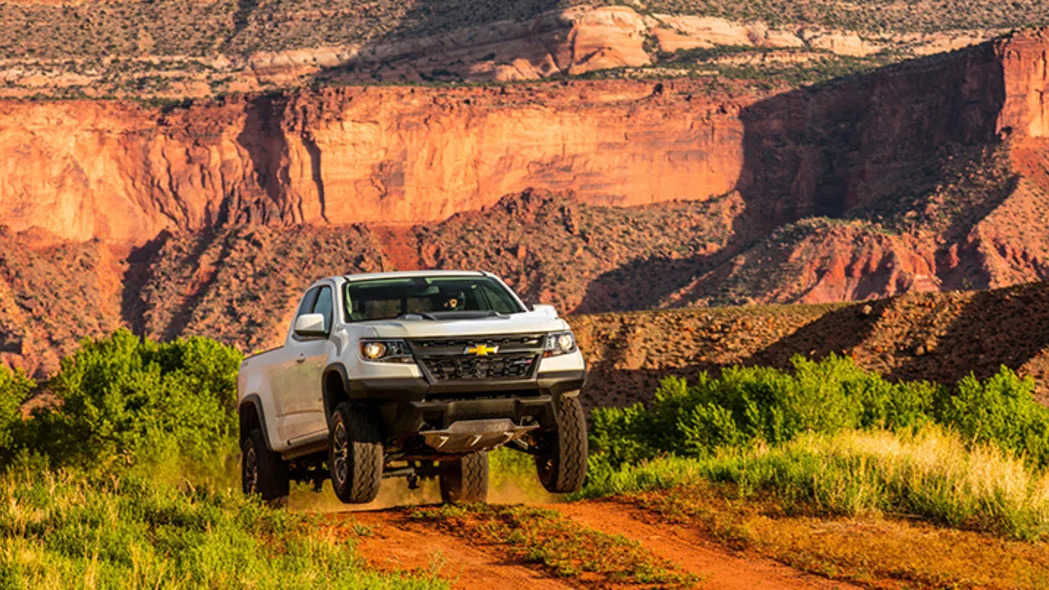
Why didn't Chevy turn to a technology like MagneRide? As Multimatic senior product Engineer David Meyer explained to me, the response rate of the magnetorheological fluid is quick enough over the small travel ranges of a road-going shock. But adapting the technology to a very long travel application like the ZR2 would involve a ton of fluid (think huge external reservoirs) and tons of heat – and the MagneRide system is sensitive to heat. Basically, it's unworkable for this application.
Cool, so the DSSV shocks are an engineer's fantasy, but what are they like on the road? If you were imagining Raptor-like Trophy Truck float, the relative firmness of the ZR2's DSSV shocks will be a surprise. It's much more like the normal Colorado, perhaps a tad stiffer and two inches taller than a Z71. So it handles a winding two-lane highway in Some Far-Flung Canyon, Colorado, just fine. For a truck. It's no sportscar, but it's enjoyable to hustle if you'd like to or need to. There's a noticeable softening when the suspension compresses beyond the point at which it picks up the third spool valve (which Multimatic calls Position Sensitive Damping), so it'll absorb a pothole on pavement mid-turn without being overly harsh or bouncing the truck off its line.
Chevy and Multimatic weren't talking replacement cost yet, but reps from both outfits assured me that the DSSV shocks have to pass the same tests as standard shocks. They insinuated the spool valve units would last about as long as any OEM shock, and they certainly stress-tested the units (a lot), so time will tell.
While the shocks are the headliner for anyone interested in this truck's capabilities, Chevy's also used the exterior of the ZR2 to communicate this truck's intentions. The hood scoop is aggressive and attractive, for starters. Up front, the deeply cut away front bumper reveals a lot of tread from a head-on view. Thick aluminum skid plates curl up from underneath and run into the lower front fascia, and to either side there are functional recovery points bolted to the frame.
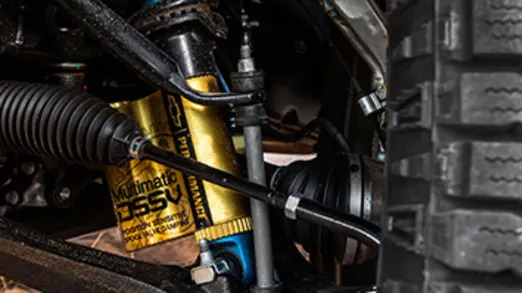
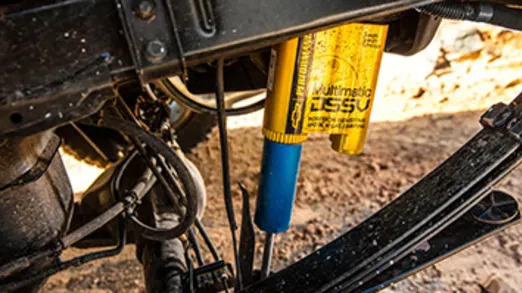
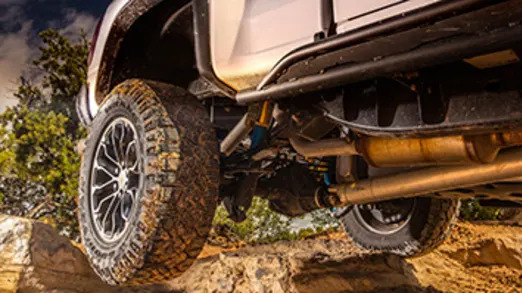
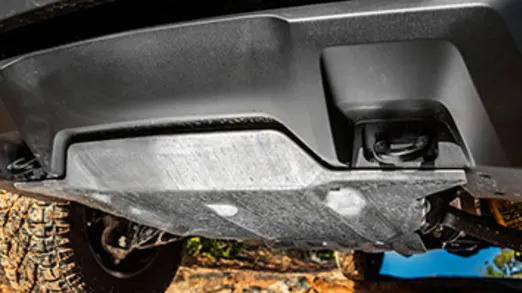
It looks burly, but the setup involves a lot of plastic (cheap to replace, I suppose), and the approach angle is only 30 degrees. That's OK for a regular 4x4 mid-size pickup, but a Wrangler Rubicon shames it at just over 42 degrees. Even the Tacoma TRD Pro, the ZR2's closest competitor, has a 36-degree approach angle. There's no factory winch mount, or provision for it behind the bumper. The GM engineers who accompanied journalists along the trail drove pre-production ZR2s carrying tons of recovery gear, including custom front receiver hitches to take a removable winch mounted on a cradle. That's actually a nice setup for occasional use – winches and mounting plates are awfully heavy – but a dedicated, optional winch bumper would improve front departure angles and keep the winch safely tucked away.
As capable as the ZR2 proved to be, this won't be the only time you'll read about a place for the aftermarket to step in and provide a solution. The only question is if it will, and how many options there will be. The Colorado isn't exactly as popular with the rock-crawling or overland crowd as the Wrangler or Tacoma. For things like the unprotected plastic fuel tank, though, surely folks will want a little extra reassurance – even if Chevy's extensive testing didn't reveal any issues with it being damaged. It looks more exposed than it is, but try telling a nervous owner that.
Along the sides of the truck, though, no complaints. Chevy bolts standard, beefy, wonderfully integrated rock sliders onto every ZR2. These things are legit; you can use 'em as recovery points, since they're bolted to reinforcing plates to spread the load along the rocker. Many aftermarket rock sliders have to be welded to the frame. The mounting points are the same as the regular Colorado's rocker steps. If Chevy's smart, it'll offer the ZR2 sliders as a Chevy Performance accessory to owners of other Colorados as an aftermarket accessory.
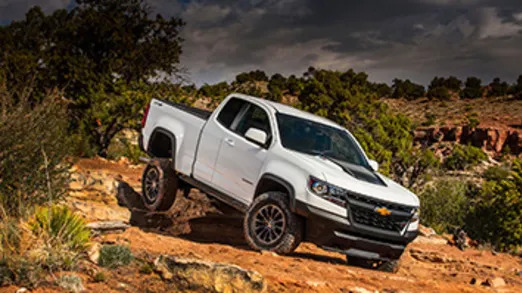
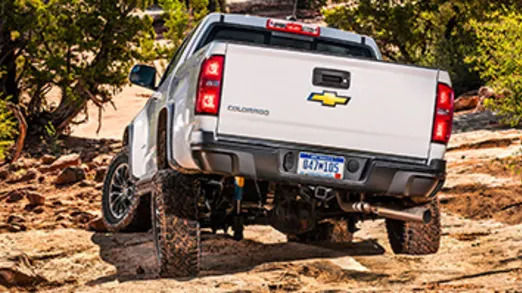


Look up from the sliders and you might think the ZR2 has wider fender flares, but that's not the case. The regular Colorado's metal flares are identical, but the ZR2's plastic outer fenders are wider to cover up the 3.5-inch wider track, and they hunker nicely over the unique and very handsome wheel design. Move around back and notice that the bumper steps have been deleted, to provide some extra departure angle (23.5 degrees, versus 24 in the TRD Pro and 32.3 in a Rubicon). Truck beds aren't great for departure angle no matter how you cut it, so a Wrangler will always have an unbobbed pickup beat. There aren't any dedicated recovery points out back, but the standard hitch receiver is an integral part of the rear bumper, and you can buy a bracket that'll pop in the receiver.
We didn't catch the front or rear on any rocks, stumps, or crests, although the skid plates and the bottom of the frame rails made contact at a few points along the rocky parts of the Bangs Canyon off-road area, maintained by the Bureau of Land Management and set in a riot of sand, cacti, and even cryptobiotic soil. (Don't step on that stuff, by the way. It looks like moldy sand but takes decades to grow back.) This is an area popular with the Jeep crowd, and there are a lot of YouTube videos of Wranglers playing on the staircase section out there. With a little help from spotters and lockers, the ZR2s made it up and down without much drama.
Yes, we said lockers in the plural. The ZR2 has two of 'em, both made by Eaton and activated by flipping two center console switches. The rear locker can be selected on its own (and in 2WD!) in case you only need a bit of scramble. With both on, the Duratracs might as well have been glued to the rock. The rock steps were dry when we went up, but it started raining later. The ZR2s further back reported that the lockers really made a difference on the ice-slick stone. The transfer case, by the way, is the familiar AutoTrac-type unit, which allows Auto 4WD (AWD) as well as a dedicated setting for 2WD, 4WD High, and 4WD Low, switched using a rotary selector.
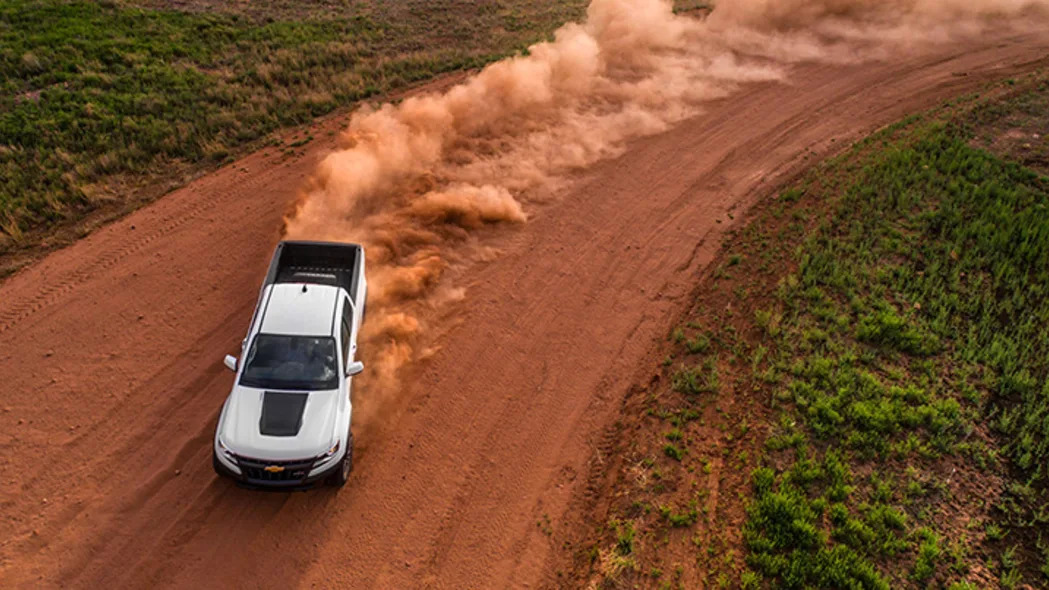
There are also some welcome options for off-roaders seeking more control over the truck's electronic safety net. For one, stab the transfer case selector knob and the truck's Off-Road Mode engages. That alters the throttle and shift calibration. Whack the stability control button and you go into what Deep, the development engineer, called "fun mode" – the truck reduces throttle intervention and allows much more yaw, but will apply the brakes to try and keep the truck from looping. A long hold and the system is theoretically off. Fun mode was indeed fun on the higher-speed dirt course, but turning everything off doesn't make it uncontrollable. The shocks help keep the Goodyears in contact with the soil, and it takes a lot of throttle with either engine to coax the thing around. It's not likely to loop on you in the dirt unless you're doing something boneheaded.
We spent all of our time in Bangs Canyon in the Duramax 2.8-liter, turbodiesel four-cylinder ZR2, which comes exclusively with a six-speed automatic. In terms of setup and equipment, there isn't much difference between it and the familiar GM 3.6-liter gas V6, other than the V6's eight-speed auto and some suspension recalibration to account for the diesel engine's greater weight over the front axle – the weight distribution is 58 percent front, versus 57 percent for the V6.
The diesel is the clear favorite for the low-speed, technical stuff. There's a fair bit of turbo lag and a rather sluggish throttle tip-in on top of that, but left-foot braking and working the throttle a bit unleashes easily controllable and prodigious torque. The 2.8 might only make 186 horsepower, but those 369 pound-feet of torque make a slow creep up a tall rock step a breeze. The extra torque is also appreciated because the crawl ratio (36.42 for the diesel, 41.39 for the gas) isn't as aggressive as we expected. Because of that, the diesel's low-end grunt is particularly appreciated.
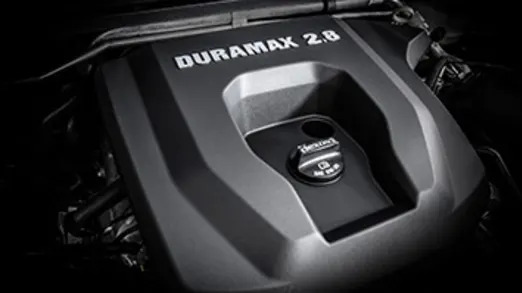

Slinging the ZR2 around in the higher-speed Trophy Truck-style course, though, the V6's quicker throttle response and lighter front end meant it was quicker to point into a turn and bite on the way out. The diesel's lag required left-foot braking and early throttle application to approximate the V6's prowess, and it couldn't keep up with the V6 in any event. The diesel is remarkably quiet from inside the cab, and the torque is wonderful, but it's a slug off the line. The quicker V6 is coarse-sounding, and the eight-speed auto likes to hunt for gears uphill. So, for every advantage there's a disadvantage.
Who cares? This is a midsize pickup with advanced off-road suspension, and the 21-gallon fuel tank (for both engines) and diesel economy gives the Duramax a range advantage. Using the EPA's combined figures, the diesel should stretch to 420 miles if you use every drop, while the V6 would manage 357 miles. Your mileage will definitely vary, but the expedition crowd will appreciate the extra range and torque.
Other than engine and cab choice (both engines are available in either extended or quad-cab configurations), there aren't many options on the ZR2. Inside, there's an optional upgraded Bose stereo system, a no-cost full vinyl floor option, and that's it. You can't get cloth seats, so don't ask. Outside, there's a premium color, Cajun Red Tintcoat, for $495, the bed-mounted spare tire mount is a dealer-installed $615 option, there's an off-road sport bar for $1,145 (lights are extra!). Everything else is included in the $40,995 base price for a V6 ZR2. The Duramax engine is a $3,500 option, so it's just a tad cheaper than that upcharge would be in a standard Colorado.
Chevy's also not limiting production any. GM's marketing gurus sent word that the ZR2 should be about 10 percent of the overall mix, they expect, but they'll readjust and build more if demand warrants it. From there, expect diesels to be a much smaller slice of that 10 percent of the Colorado pie.



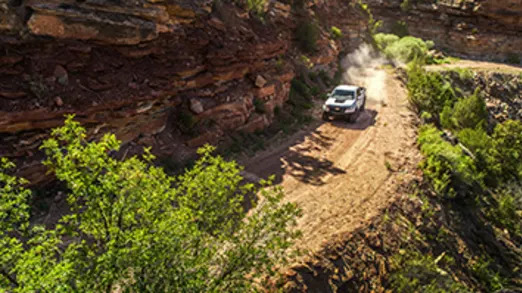
The elephant in the Colorado's bed is the Toyota Tacoma, which outsells the Chevy handily. Even though the ZR2 undercuts the Tacoma TRD Pro automatic's starting price of $43,920 by $2,925, the Tacoma has the built-in advantage of better approach and departure angles and an available manual transmission (that knocks the price difference to under $1,000). Sure, the TRD Pro isn't as focused a vehicle as the ZR2, but as we found out in Hawaii it's awfully capable. It's also got a more truckish interior, albeit a bit over the top, whereas the Colorado seems more generic GM inside and not particularly distinctive though comfortable and functional. The difference between the TRD Pro and the ZR2 has more to do with attitude than ultimate capability.
And then there's the complicated issue of what the aftermarket can do to a Tacoma SR5 V6 4x4 quad cab with the $7,000 or so you'll save over a ZR2. The aftermarket is important in this segment, so this isn't just quibbling about something that real buyers won't be considering.
What you can't get on a Tacoma, even in the aftermarket, is a diesel engine or the DSSV shocks. Interestingly, the diesel doesn't prove to be as much of an advantage over the Tacoma as you'd think: with a combined rating of 20 mpg, the EPA thinks the V6 auto 4x4 quad cab Tacoma should go 422 miles on its 21.1 gallon tank. But the diesel's exceptional low-end grunt, and the sure on-road handling of the DSSV shocks, can't be replicated in the Tacoma.
The Ford F-150 Raptor also has to be mentioned, although it couldn't be called a competitor with a straight face. A Raptor starts at $50,560 – good luck finding one at that price – and its entire mission is different. It's a street-legal Trophy Truck built for high-speed rips through the desert, and capable of landing hard after taking flight. It's on another level, and even though it'll pick through the slow stuff, the Colorado and Tacoma are far better suited for narrow trails and technical obstacles. If you want a Raptor, the ZR2 won't rustle your jimmies, and vice versa.
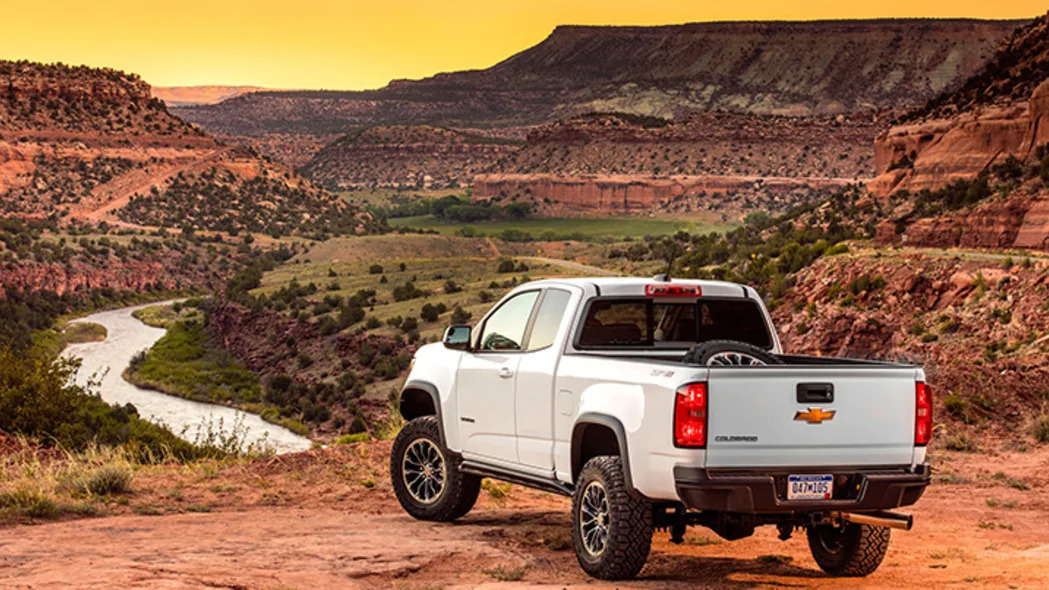
So who needs a ZR2? For one, the Chevy die-hards, who haven't had the factory support to chase the Tacoma up the rudest trails. Even more than the original S-10 ZR2, this one has the goods, right off the showroom floor, to get dirty. GM engineers took bone stock production ZR2 trucks up the Rubicon Trail in about three days, several of them told me, and the trucks didn't have any significant issues. We examined the underside of one Rubicon truck, and it bore their claims out.
The other real appeal is the unique and charismatic combination of the DSSV shocks and the Duramax diesel engine, which made traveling over the mild two-tracks and more technical staircases a breeze. Excellent economy and long range could make it the darling of the expedition crowd, so long as the aftermarket steps up to offer the sort of bed racks and swing-out bumpers those folks love to hang gear off of. Decent fabricators will assuredly jump out ahead of the commercial aftermarket in this regard. In any even, this is the ZR2's strongest hand: a compelling drivetrain and advanced, highly functional shocks.
Our day ended with a jaunt on the Tabeguache Trail, which we picked over for a few too-short miles between the Mica Mine Trail and Rough Canyon Falls. There's 142 total miles of Tabeguache, running from the eye-popping cliffs of the Colorado National Monument all the way to Montrose where the Million Dollar Highway begins. The Tabeguache is wild, with no services along the way and practically impassable when wet or snowy. That should be enough to scare most folks off of trying to run the whole trail, but if that description makes you restless to see it all for yourself, the ZR2 might be the truck for you.
Related Video:
I watch one last ZR2 go four wheels up over the main event on the front straight, and thick balls of rain – "drops" wouldn't do 'em justice, they're really mostly-melted hail – start slamming into the ground, the corrugated roof of the rustic hospitality shed, the steel of the trucks. Thunder drifts through the valley. This is good news for the thirsty plants of an unexpectedly green Western Colorado, and better news for us. The rain will erase the ruts our trucks clawed out, and it should be smooth sailing for the next group.
The high-speed stuff puts the ZR2's main party trick on display: Multimatic-developed, specialized Dynamic Suspensions Spool Valve (DSSV) shocks. The spool valve's theoretical simplicity belies the complicated knowledge of fluid dynamics necessary to understand its intricacies. The short version is that oil is forced, progressively, through an irregularly shaped orifice. As the smaller end of the port is exposed, fluid pressure is high. As the rest of the port is exposed, pressure is reduced. Changing the shape of the orifice changes the damping curve. Since the ZR2 has a total of three spool valves (one for compression, one for rebound, and a third one that helps control damping during large compression events), there's a massive degree of customization of the damping curve throughout the stroke of the piston.

Why didn't Chevy turn to a technology like MagneRide? As Multimatic senior product Engineer David Meyer explained to me, the response rate of the magnetorheological fluid is quick enough over the small travel ranges of a road-going shock. But adapting the technology to a very long travel application like the ZR2 would involve a ton of fluid (think huge external reservoirs) and tons of heat – and the MagneRide system is sensitive to heat. Basically, it's unworkable for this application.
Cool, so the DSSV shocks are an engineer's fantasy, but what are they like on the road? If you were imagining Raptor-like Trophy Truck float, the relative firmness of the ZR2's DSSV shocks will be a surprise. It's much more like the normal Colorado, perhaps a tad stiffer and two inches taller than a Z71. So it handles a winding two-lane highway in Some Far-Flung Canyon, Colorado, just fine. For a truck. It's no sportscar, but it's enjoyable to hustle if you'd like to or need to. There's a noticeable softening when the suspension compresses beyond the point at which it picks up the third spool valve (which Multimatic calls Position Sensitive Damping), so it'll absorb a pothole on pavement mid-turn without being overly harsh or bouncing the truck off its line.
Chevy and Multimatic weren't talking replacement cost yet, but reps from both outfits assured me that the DSSV shocks have to pass the same tests as standard shocks. They insinuated the spool valve units would last about as long as any OEM shock, and they certainly stress-tested the units (a lot), so time will tell.
While the shocks are the headliner for anyone interested in this truck's capabilities, Chevy's also used the exterior of the ZR2 to communicate this truck's intentions. The hood scoop is aggressive and attractive, for starters. Up front, the deeply cut away front bumper reveals a lot of tread from a head-on view. Thick aluminum skid plates curl up from underneath and run into the lower front fascia, and to either side there are functional recovery points bolted to the frame.




It looks burly, but the setup involves a lot of plastic (cheap to replace, I suppose), and the approach angle is only 30 degrees. That's OK for a regular 4x4 mid-size pickup, but a Wrangler Rubicon shames it at just over 42 degrees. Even the Tacoma TRD Pro, the ZR2's closest competitor, has a 36-degree approach angle. There's no factory winch mount, or provision for it behind the bumper. The GM engineers who accompanied journalists along the trail drove pre-production ZR2s carrying tons of recovery gear, including custom front receiver hitches to take a removable winch mounted on a cradle. That's actually a nice setup for occasional use – winches and mounting plates are awfully heavy – but a dedicated, optional winch bumper would improve front departure angles and keep the winch safely tucked away.
As capable as the ZR2 proved to be, this won't be the only time you'll read about a place for the aftermarket to step in and provide a solution. The only question is if it will, and how many options there will be. The Colorado isn't exactly as popular with the rock-crawling or overland crowd as the Wrangler or Tacoma. For things like the unprotected plastic fuel tank, though, surely folks will want a little extra reassurance – even if Chevy's extensive testing didn't reveal any issues with it being damaged. It looks more exposed than it is, but try telling a nervous owner that.
Along the sides of the truck, though, no complaints. Chevy bolts standard, beefy, wonderfully integrated rock sliders onto every ZR2. These things are legit; you can use 'em as recovery points, since they're bolted to reinforcing plates to spread the load along the rocker. Many aftermarket rock sliders have to be welded to the frame. The mounting points are the same as the regular Colorado's rocker steps. If Chevy's smart, it'll offer the ZR2 sliders as a Chevy Performance accessory to owners of other Colorados as an aftermarket accessory.




Look up from the sliders and you might think the ZR2 has wider fender flares, but that's not the case. The regular Colorado's metal flares are identical, but the ZR2's plastic outer fenders are wider to cover up the 3.5-inch wider track, and they hunker nicely over the unique and very handsome wheel design. Move around back and notice that the bumper steps have been deleted, to provide some extra departure angle (23.5 degrees, versus 24 in the TRD Pro and 32.3 in a Rubicon). Truck beds aren't great for departure angle no matter how you cut it, so a Wrangler will always have an unbobbed pickup beat. There aren't any dedicated recovery points out back, but the standard hitch receiver is an integral part of the rear bumper, and you can buy a bracket that'll pop in the receiver.
We didn't catch the front or rear on any rocks, stumps, or crests, although the skid plates and the bottom of the frame rails made contact at a few points along the rocky parts of the Bangs Canyon off-road area, maintained by the Bureau of Land Management and set in a riot of sand, cacti, and even cryptobiotic soil. (Don't step on that stuff, by the way. It looks like moldy sand but takes decades to grow back.) This is an area popular with the Jeep crowd, and there are a lot of YouTube videos of Wranglers playing on the staircase section out there. With a little help from spotters and lockers, the ZR2s made it up and down without much drama.
Yes, we said lockers in the plural. The ZR2 has two of 'em, both made by Eaton and activated by flipping two center console switches. The rear locker can be selected on its own (and in 2WD!) in case you only need a bit of scramble. With both on, the Duratracs might as well have been glued to the rock. The rock steps were dry when we went up, but it started raining later. The ZR2s further back reported that the lockers really made a difference on the ice-slick stone. The transfer case, by the way, is the familiar AutoTrac-type unit, which allows Auto 4WD (AWD) as well as a dedicated setting for 2WD, 4WD High, and 4WD Low, switched using a rotary selector.

There are also some welcome options for off-roaders seeking more control over the truck's electronic safety net. For one, stab the transfer case selector knob and the truck's Off-Road Mode engages. That alters the throttle and shift calibration. Whack the stability control button and you go into what Deep, the development engineer, called "fun mode" – the truck reduces throttle intervention and allows much more yaw, but will apply the brakes to try and keep the truck from looping. A long hold and the system is theoretically off. Fun mode was indeed fun on the higher-speed dirt course, but turning everything off doesn't make it uncontrollable. The shocks help keep the Goodyears in contact with the soil, and it takes a lot of throttle with either engine to coax the thing around. It's not likely to loop on you in the dirt unless you're doing something boneheaded.
We spent all of our time in Bangs Canyon in the Duramax 2.8-liter, turbodiesel four-cylinder ZR2, which comes exclusively with a six-speed automatic. In terms of setup and equipment, there isn't much difference between it and the familiar GM 3.6-liter gas V6, other than the V6's eight-speed auto and some suspension recalibration to account for the diesel engine's greater weight over the front axle – the weight distribution is 58 percent front, versus 57 percent for the V6.
The diesel is the clear favorite for the low-speed, technical stuff. There's a fair bit of turbo lag and a rather sluggish throttle tip-in on top of that, but left-foot braking and working the throttle a bit unleashes easily controllable and prodigious torque. The 2.8 might only make 186 horsepower, but those 369 pound-feet of torque make a slow creep up a tall rock step a breeze. The extra torque is also appreciated because the crawl ratio (36.42 for the diesel, 41.39 for the gas) isn't as aggressive as we expected. Because of that, the diesel's low-end grunt is particularly appreciated.


Slinging the ZR2 around in the higher-speed Trophy Truck-style course, though, the V6's quicker throttle response and lighter front end meant it was quicker to point into a turn and bite on the way out. The diesel's lag required left-foot braking and early throttle application to approximate the V6's prowess, and it couldn't keep up with the V6 in any event. The diesel is remarkably quiet from inside the cab, and the torque is wonderful, but it's a slug off the line. The quicker V6 is coarse-sounding, and the eight-speed auto likes to hunt for gears uphill. So, for every advantage there's a disadvantage.
Who cares? This is a midsize pickup with advanced off-road suspension, and the 21-gallon fuel tank (for both engines) and diesel economy gives the Duramax a range advantage. Using the EPA's combined figures, the diesel should stretch to 420 miles if you use every drop, while the V6 would manage 357 miles. Your mileage will definitely vary, but the expedition crowd will appreciate the extra range and torque.
Other than engine and cab choice (both engines are available in either extended or quad-cab configurations), there aren't many options on the ZR2. Inside, there's an optional upgraded Bose stereo system, a no-cost full vinyl floor option, and that's it. You can't get cloth seats, so don't ask. Outside, there's a premium color, Cajun Red Tintcoat, for $495, the bed-mounted spare tire mount is a dealer-installed $615 option, there's an off-road sport bar for $1,145 (lights are extra!). Everything else is included in the $40,995 base price for a V6 ZR2. The Duramax engine is a $3,500 option, so it's just a tad cheaper than that upcharge would be in a standard Colorado.
Chevy's also not limiting production any. GM's marketing gurus sent word that the ZR2 should be about 10 percent of the overall mix, they expect, but they'll readjust and build more if demand warrants it. From there, expect diesels to be a much smaller slice of that 10 percent of the Colorado pie.




The elephant in the Colorado's bed is the Toyota Tacoma, which outsells the Chevy handily. Even though the ZR2 undercuts the Tacoma TRD Pro automatic's starting price of $43,920 by $2,925, the Tacoma has the built-in advantage of better approach and departure angles and an available manual transmission (that knocks the price difference to under $1,000). Sure, the TRD Pro isn't as focused a vehicle as the ZR2, but as we found out in Hawaii it's awfully capable. It's also got a more truckish interior, albeit a bit over the top, whereas the Colorado seems more generic GM inside and not particularly distinctive though comfortable and functional. The difference between the TRD Pro and the ZR2 has more to do with attitude than ultimate capability.
And then there's the complicated issue of what the aftermarket can do to a Tacoma SR5 V6 4x4 quad cab with the $7,000 or so you'll save over a ZR2. The aftermarket is important in this segment, so this isn't just quibbling about something that real buyers won't be considering.
What you can't get on a Tacoma, even in the aftermarket, is a diesel engine or the DSSV shocks. Interestingly, the diesel doesn't prove to be as much of an advantage over the Tacoma as you'd think: with a combined rating of 20 mpg, the EPA thinks the V6 auto 4x4 quad cab Tacoma should go 422 miles on its 21.1 gallon tank. But the diesel's exceptional low-end grunt, and the sure on-road handling of the DSSV shocks, can't be replicated in the Tacoma.
The Ford F-150 Raptor also has to be mentioned, although it couldn't be called a competitor with a straight face. A Raptor starts at $50,560 – good luck finding one at that price – and its entire mission is different. It's a street-legal Trophy Truck built for high-speed rips through the desert, and capable of landing hard after taking flight. It's on another level, and even though it'll pick through the slow stuff, the Colorado and Tacoma are far better suited for narrow trails and technical obstacles. If you want a Raptor, the ZR2 won't rustle your jimmies, and vice versa.

So who needs a ZR2? For one, the Chevy die-hards, who haven't had the factory support to chase the Tacoma up the rudest trails. Even more than the original S-10 ZR2, this one has the goods, right off the showroom floor, to get dirty. GM engineers took bone stock production ZR2 trucks up the Rubicon Trail in about three days, several of them told me, and the trucks didn't have any significant issues. We examined the underside of one Rubicon truck, and it bore their claims out.
The other real appeal is the unique and charismatic combination of the DSSV shocks and the Duramax diesel engine, which made traveling over the mild two-tracks and more technical staircases a breeze. Excellent economy and long range could make it the darling of the expedition crowd, so long as the aftermarket steps up to offer the sort of bed racks and swing-out bumpers those folks love to hang gear off of. Decent fabricators will assuredly jump out ahead of the commercial aftermarket in this regard. In any even, this is the ZR2's strongest hand: a compelling drivetrain and advanced, highly functional shocks.
Our day ended with a jaunt on the Tabeguache Trail, which we picked over for a few too-short miles between the Mica Mine Trail and Rough Canyon Falls. There's 142 total miles of Tabeguache, running from the eye-popping cliffs of the Colorado National Monument all the way to Montrose where the Million Dollar Highway begins. The Tabeguache is wild, with no services along the way and practically impassable when wet or snowy. That should be enough to scare most folks off of trying to run the whole trail, but if that description makes you restless to see it all for yourself, the ZR2 might be the truck for you.
Related Video:









Sign in to post
Please sign in to leave a comment.
Continue